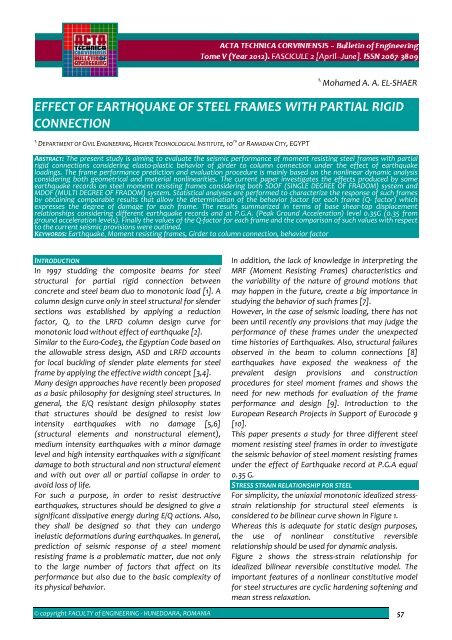Editorial & Advisory Board - Acta Technica Corviniensis
Editorial & Advisory Board - Acta Technica Corviniensis
Editorial & Advisory Board - Acta Technica Corviniensis
Create successful ePaper yourself
Turn your PDF publications into a flip-book with our unique Google optimized e-Paper software.
1.<br />
Mohamed A. A. EL‐SHAER<br />
EFFECT OF EARTHQUAKE OF STEEL FRAMES WITH PARTIAL RIGID<br />
CONNECTION<br />
1.<br />
DEPARTMENT OF CIVIL ENGINEERING, HIGHER TECHNOLOGICAL INSTITUTE, 10 TH OF RAMADAN CITY, EGYPT<br />
ABSTRACT: The present study is aiming to evaluate the seismic performance of moment resisting steel frames with partial<br />
rigid connections considering elasto‐plastic behavior of girder to column connection under the effect of earthquake<br />
loadings. The frame performance prediction and evaluation procedure is mainly based on the nonlinear dynamic analysis<br />
considering both geometrical and material nonlinearities. The current paper investigates the effects produced by some<br />
earthquake records on steel moment resisting frames considering both SDOF (SINGLE DEGREE OF FRADOM) system and<br />
MDOF (MULTI DEGREE OF FRADOM) system. Statistical analyses are performed to characterize the response of such frames<br />
by obtaining comparable results that allow the determination of the behavior factor for each frame (Q‐ factor) which<br />
expresses the degree of damage for each frame. The results summarized in terms of base shear‐top displacement<br />
relationships considering different earthquake records and at P.G.A. (Peak Ground Acceleration) level 0.35G (0.35 from<br />
ground acceleration levels). Finally the values of the Q‐factor for each frame and the comparison of such values with respect<br />
to the current seismic provisions were outlined.<br />
KEYWORDS: Earthquake, Moment resisting frames, Girder to column connection, behavior factor<br />
INTRODUCTION<br />
In 1997 studding the composite beams for steel<br />
structural for partial rigid connection between<br />
concrete and steel beam duo to monotonic load [1]. A<br />
column design curve only in steel structural for slender<br />
sections was established by applying a reduction<br />
factor, Q, to the LRFD column design curve for<br />
monotonic load without effect of earthquake [2].<br />
Similar to the Euro‐Code3, the Egyptian Code based on<br />
the allowable stress design, ASD and LRFD accounts<br />
for local buckling of slender plate elements for steel<br />
frame by applying the effective width concept [3,4].<br />
Many design approaches have recently been proposed<br />
as a basic philosophy for designing steel structures. In<br />
general, the E/Q resistant design philosophy states<br />
that structures should be designed to resist low<br />
intensity earthquakes with no damage [5,6]<br />
(structural elements and nonstructural element),<br />
medium intensity earthquakes with a minor damage<br />
level and high intensity earthquakes with a significant<br />
damage to both structural and non structural element<br />
and with out over all or partial collapse in order to<br />
avoid loss of life.<br />
For such a purpose, in order to resist destructive<br />
earthquakes, structures should be designed to give a<br />
significant dissipative energy during E/Q actions. Also,<br />
they shall be designed so that they can undergo<br />
inelastic deformations during earthquakes. In general,<br />
prediction of seismic response of a steel moment<br />
resisting frame is a problematic matter, due not only<br />
to the large number of factors that affect on its<br />
performance but also due to the basic complexity of<br />
its physical behavior.<br />
In addition, the lack of knowledge in interpreting the<br />
MRF (Moment Resisting Frames) characteristics and<br />
the variability of the nature of ground motions that<br />
may happen in the future, create a big importance in<br />
studying the behavior of such frames [7].<br />
However, in the case of seismic loading, there has not<br />
been until recently any provisions that may judge the<br />
performance of these frames under the unexpected<br />
time histories of Earthquakes. Also, structural failures<br />
observed in the beam to column connections [8]<br />
earthquakes have exposed the weakness of the<br />
prevalent design provisions and construction<br />
procedures for steel moment frames and shows the<br />
need for new methods for evaluation of the frame<br />
performance and design [9]. Introduction to the<br />
European Research Projects in Support of Eurocode 9<br />
[10].<br />
This paper presents a study for three different steel<br />
moment resisting steel frames in order to investigate<br />
the seismic behavior of steel moment resisting frames<br />
under the effect of Earthquake record at P.G.A equal<br />
0.35 G.<br />
STRESS STRAIN RELATIONSHIP FOR STEEL<br />
For simplicity, the uniaxial monotonic idealized stressstrain<br />
relationship for structural steel elements is<br />
considered to be bilinear curve shown in Figure 1.<br />
Whereas this is adequate for static design purposes,<br />
the use of nonlinear constitutive reversible<br />
relationship should be used for dynamic analysis.<br />
Figure 2 shows the stress‐strain relationship for<br />
idealized bilinear reversible constitutive model. The<br />
important features of a nonlinear constitutive model<br />
for steel structures are cyclic hardening softening and<br />
mean stress relaxation.<br />
© copyright FACULTY of ENGINEERING ‐ HUNEDOARA, ROMANIA 57

















